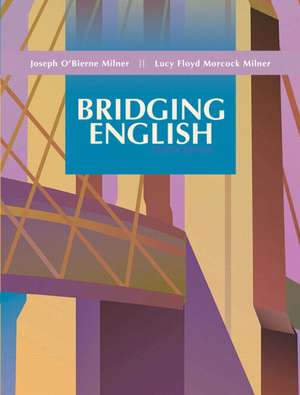Bridging English
Autor Joseph O. Milner, Lucy F. Milneren Limba Engleză Paperback – 14 iun 2007
Preț: 555.48 lei
Preț vechi: 638.48 lei
-13% Nou
Puncte Express: 833
Preț estimativ în valută:
106.31€ • 110.04$ • 89.85£
106.31€ • 110.04$ • 89.85£
Carte indisponibilă temporar
Doresc să fiu notificat când acest titlu va fi disponibil:
Se trimite...
Preluare comenzi: 021 569.72.76
Specificații
ISBN-13: 9780132397476
ISBN-10: 0132397471
Pagini: 528
Dimensiuni: 210 x 276 x 20 mm
Greutate: 0.99 kg
Ediția:4Nouă
Editura: Pearson Education
Colecția Allyn & Bacon
Locul publicării:Boston, United States
ISBN-10: 0132397471
Pagini: 528
Dimensiuni: 210 x 276 x 20 mm
Greutate: 0.99 kg
Ediția:4Nouă
Editura: Pearson Education
Colecția Allyn & Bacon
Locul publicării:Boston, United States
Cuprins
Chapter 1 — Envisioning English
Chapter 2 — Designing Instruction
Chapter 3 — Centering on Language
Chapter 4 — Developing an Oral Foundation
Chapter 4 — Developing an Oral Foundation
Chapter 5 — Responding to Literature
Chapter 6 — Celebrating Poetry
Chapter 7 — Opening Texts
Chapter 8 — Engaging Drama
Chapter 9 — Assaying Nonfiction
Chapter 10 — Making Media Matter
Chapter 11 — Inspiring Writing
Chapter 12 — Enabling Writing
Chapter 13 — Evaluating Learning
Chapter 14 — Planning Lessons
Chapter 15 — Becoming a Complete Teacher
Appendix A
NCTE and IRA Standards for the English Language Arts
Appendix B
Meiers’ Independent Project for English: Collecting and Writing a Personal Anthology
Possible Literature Lessons on Shakespeare’s Sonnet 116
Internet Resources (Compiled by Katherine Thompson)
Appendix C
Oral Language Resources
Appendix D
Rabinowitz’s Rules of Notice
Appendix E
U.S. Poet Laureates, 1937-2006
Brown’s Poetry Response Assignment, 1991-1992
Brown’s Explanation of Her Poetry Assignment’s Evolution
Brown’s Poetry Response Assignment, 2001-2006
Books on Poetry and Poetry Teaching
Appendix F
Works on Censorship
Appendix G
Smith’s Guide for Making Movies in the Classroom
Appendix H
Recommended Writing Textbooks
Appendix I
SAT Essay Exam Assessment: Diederich Scale
Appendix J
Developing a Unit: William Shakespeare
Appendix K
NCTE Organizations and Periodicals for the English Teacher
Educational Periodicals Recommended for the English Teacher
References
Index
Chapter 2 — Designing Instruction
Chapter 3 — Centering on Language
Chapter 4 — Developing an Oral Foundation
Chapter 4 — Developing an Oral Foundation
Chapter 5 — Responding to Literature
Chapter 6 — Celebrating Poetry
Chapter 7 — Opening Texts
Chapter 8 — Engaging Drama
Chapter 9 — Assaying Nonfiction
Chapter 10 — Making Media Matter
Chapter 11 — Inspiring Writing
Chapter 12 — Enabling Writing
Chapter 13 — Evaluating Learning
Chapter 14 — Planning Lessons
Chapter 15 — Becoming a Complete Teacher
Appendix A
NCTE and IRA Standards for the English Language Arts
Appendix B
Meiers’ Independent Project for English: Collecting and Writing a Personal Anthology
Possible Literature Lessons on Shakespeare’s Sonnet 116
Internet Resources (Compiled by Katherine Thompson)
Appendix C
Oral Language Resources
Appendix D
Rabinowitz’s Rules of Notice
Appendix E
U.S. Poet Laureates, 1937-2006
Brown’s Poetry Response Assignment, 1991-1992
Brown’s Explanation of Her Poetry Assignment’s Evolution
Brown’s Poetry Response Assignment, 2001-2006
Books on Poetry and Poetry Teaching
Appendix F
Works on Censorship
Appendix G
Smith’s Guide for Making Movies in the Classroom
Appendix H
Recommended Writing Textbooks
Appendix I
SAT Essay Exam Assessment: Diederich Scale
Appendix J
Developing a Unit: William Shakespeare
Appendix K
NCTE Organizations and Periodicals for the English Teacher
Educational Periodicals Recommended for the English Teacher
References
Index
Caracteristici
- English language learners and methods-Increasingly young teachers are faced with addressing the specific needs of the growing number of English language learners in American schools. The book profiles these students and presents some of the most salient research and practice in teaching them language arts.
- Struggling and reluctant readers-Like the challenge of English language learners, teachers-young teachers especially who are often assigned the most challenging students-must address the needs of struggling and reluctant readers. Although the methods presented are promising with all students, the authors give more attention in this edition to specific strategies for these students. This book draws especially on the work of Jeff Wilhelm and KyleneBeers.
- Technological Resources-Throughout this edition, the authors suggest instructional uses of technology. In the appendices, they have a comprehensive list of Internet resources for teachers of English. A Companion Website is available for readers to access for additional lists, ideas, information, and strategies for teaching.
- Chapter organizers-Graphic organizers for all of the major and multi-faceted chapters to enable readers to make their way more easily are placed throughout the text. The authors have also made clear cross references to chapters so that university teachers can choose the order in which they assign chapters and readers can navigate the chapters more clearly regardless of the order.
- New insights from the general field of pedagogy-New material on topics such as differentiation, accountable talk, backwards design planning process, inquiry-based unit planning, essential questions, Socratic seminar, block scheduling, homework, and the effects of No Child Left Behind legislation.
